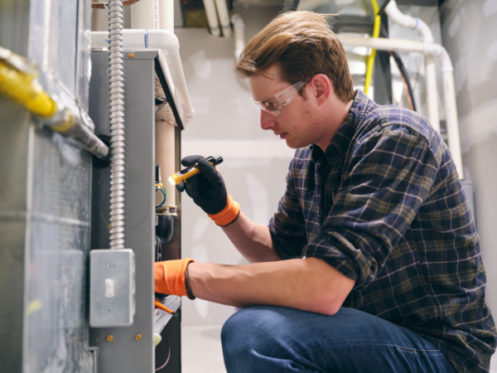When selecting a new furnace for your Austin, TX home, you’ll find a downright daunting range of options to choose from. There are electric, gas-fired, and oil-fired furnaces, and mid-efficiency and high-efficiency models. There are single-stage and two-stage furnaces along with a wealth of available features, functions, and amenities. If this isn’t confusing enough, there are also upflow and downflow models that distribute heated air in radically different ways. To help you make an informed decision and one that’s perfectly in line with your goals, the following is everything you need to know about upflow and downflow furnaces.
What Is an Upflow Furnace?
In terms of producing heat, upflow and downflow furnaces work much the same. These units combust fuel, absorb heat in their heat exchangers, route exhaust gases out of buildings, and distribute conditioned air via ducting. The main difference between the two lies in the direction in which air moves.
In an upflow furnace, incoming air enters from the bottom and exits from the top into HVAC air ducts. This setup capitalizes on heat’s tendency to rise and makes upflow furnaces an efficient choice for regions with exceedingly cold winter temperatures. Upflow furnaces are most popular in northern regions, but they also perform well in other settings where winter temperatures regularly fall below freezing.
What Downflow Furnaces Are and How They Work
Downflow furnaces take in air from the top. After heating air in their heat exchangers, they release it from the bottom into HVAC air ducts. Downflow furnaces are often installed in attics or service closets on the top floors of homes, and upflow furnaces tend to work best in low-lying basement areas.
Which Is Better
Throughout the nation, upflow furnaces are the most popular choice due to their higher levels of efficiency. Having your furnace installed in a low-lying area ensures that rising heat provides the greatest benefits for all building residents. The primary drawback of upflow models is that they come with strict requirements for installation. These requirements come from both product manufacturers and local and federal building codes.
If you don’t have a basement, if your basement cannot accommodate an upflow furnace, or if your basement is flood-prone, having a downflow furnace installed on the upper level of your home is a better choice. Downflow furnaces can prove highly efficient in warmer climates with moderate winters, but they don’t fare well in areas with long cold seasons. The warm air that these units produce is constantly fighting against the natural flow of heat. As such, in the wrong environments, downflow furnaces can sustain a lot of unnecessary wear while in heating mode, and they’ll likely have shorter lifespans as a result.
Which Option Is Better for Your Austin, TX Home
The first step in determining whether or not an upflow or downflow furnace is right for your home is finding out whether the building can accommodate either furnace type. If you don’t have a functional basement or another code-compliant, low-lying area for furnace storage, you won’t be able to install an upflow furnace.
Fortunately, winter temperatures in Austin, TX are fairly mild. Throughout the daylight hours, average temps rarely dip below the mid-60s. At night, residents shouldn’t expect to see winter temperatures below 40 degrees Fahrenheit. This makes Austin the perfect location for downflow heating. There’s also the fact that Austin terrain isn’t ideal for basement construction. This is why very few homes in the region have them. Many neighborhoods are built directly on top of thick limestone that’s both difficult and costly to cut into when digging basements out.
Optimizing the Efficiency of Your Downflow Furnace
While upflow furnaces are the top choice throughout the nation, they’re much less popular in Austin due to building-related constraints and milder winter temperatures. Although downflow furnaces don’t allow residents to capitalize on rising heat, there are ways to optimize their efficiency. Foremost among these is creating a tight envelope with adequate insulating materials, high-quality windows and doors, weatherstripping, and other efficiency-related improvements. Ceiling fans and other additions can also help push warm air down into living areas, even as these features remain viable for summertime use when they’ll assist with cooling.
We’ve been proudly serving Austin, TX since 1984. Our clients can turn to us for top-notch air conditioner and heater installation, maintenance, and repair services. We also provide air purifiers, carbon monoxide detectors, and indoor air quality solutions. For help choosing your next furnace, give Quality Cooling & Heating a call.


